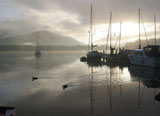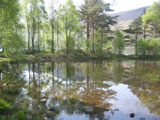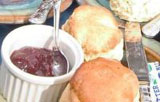|
|
Lake District
Mountain and Fell Walks
9 Great Gable
Start and finish: Honister Pass (GR
226135). Distance / Ascent: 8.5km
(5 miles), 1700m (2,300ft). Allow 5 hours.
Highest point: Great Gable summit 899m (2,949ft)
Steep-sided and high, the bowler hat shape of Gable is recognisable from
almost any other summit. The high sides suggest a toilsome ascent. From
Honister, however, there is a route up Great Gable that starts high and
undulates. And there is a way back that wanders round the side, and views
the cliff scenery from underneath.
From the uphill end of the car park, a path heads steeply uphill to left
of the mine buildings. The newly-built pitched path makes the climb fairly
easy. The path ends at a stile 200m (220 yards) short of Grey Knotts'
summit. But where is that summit, among the knolls and tiny pools?
When you've had enough of looking for it, head southwest along the remains
of an iron fence to the cairn on Brandreth. The fence remnant continues to
the tarns at Gillercomb Head, and now a wide path with cairns leads up
onto Green Gable. Eroded zigzags lead down into Windy Gap. This is a fine
pass, with steep nasty-looking screes descending on both sides and crags
ahead. The path up Great Gable keeps to left of the crag, but it is steep,
with short steps up bare rock. As the ground eases, the path crosses
boulders and stones, with many cairns, to the summit outcrop.
Gable's top, when you finally get there, is
barely worth it. It's a wide plateau of rocks - and because it's so wide,
and high, there almost isn't any view at all. And yet Great Gable remains
one of the most frequently trodden spots in all Cumbria. It's even popular
with the dead: the fell-runner Joss Naylor has complained in print about
the number of people who have their ashes scattered here, and the
consequent bony grit in his trainers.
Attached to the summit rocks is the Fell & Rock Clubs brass plate, a
relief map of central Lakeland. The actual memorial consists of the
mountains themselves: Great Gable, the Scafells, and surrounding bills.
These were purchased in memory of Lakeland climbers who died in the two
World Wars. A service is held on the summit of Great Gable on
Commemoration Day every November.
Although the plateau of Gable hides much of the surrounding ground,
there is a truly superb viewpoint just 150 m (160 yards) to the southwest.
For every hundred on the summit, only half a dozen eat their sandwiches
around the Westmorland Cairn. But from the Westmorland Cairn, there is a
view down onto the sweeping red screes of Great Hell Gate and the spiky
ridges that top off the Nape's Buttress almost directly below; then out
along the length of Wasdale to the sea. The fields of Wasdale Head, their
layout unchanged since the Middle Ages and possibly even prehistoric, are
peculiarly satisfying.
Even when it isn't misty, it's
difficult to find paths off Great Gable. The stones do not show
footprints, the curve of the hill hides the ridges, and in any direction
you look there is a cairn. To find the path for Beck Head, head directly
away from the memorial plaque - the direction is northwest. At the edge of
the plateau the path becomes visible. It's an awkward descent, on bare
rock, then jammed stones, then scree.
It isn't necessary to descend all the way to the col: 50m (150ft)
vertically above Beckhead the main path turns left to down to that col,
but our path turns down right onto the north face of the mountain.
The path was also called "Moses Sledgate", and was used for hauling slate
from Honister around the mountain and down into Wasdale for the port at
Ravenglass. However, Moses was a smuggler, with an illegal whisky still in
a cave on the southern side of Great Gable. The smugglers chose their
route cleverly. Starting in Wasdale, the path ends ambiguously in either
Borrowdale or Buttermere; but is observed only by watchers in Ennerdate.
The Moses Trod path descends at first before traversing the wide north
slopes of Gable. The path passes like a whisper in the night below the
crags and screes of Gable, and then of Green Gable. Hill walkers may
choose to cross the boulders of Gable's summit but smugglers have more
sense!
The path approaches the tarns at Gillercomb Head, passed on the outward
journey. But to reach the tarns would be uphill, so instead the path bears
away left, contouring around the slope of Brandreth.
On warm sunny days in late June and into July, the mountain ringlet
butterfly flutters across the grassy slopes between Grey Knotts and Dubs
Bottom. This is England's one truly mountain butterfly, and is found only
in the Lake District above the 400m (1,30Oft) contour - it was discovered
near Ambleside in 1809.
The Moses Trod path bends gradually left, and descends with large cairns
to the highest point of the disused tramway. This was a sort of railway,
powered by winch and cable, used to haul slate from the Dubs Quarry to
Honister Pass.
Mount the embankment onto the tramway path, and head down it to the right.
As the slope steepens, an erosion control path beads off to the left,
rejoining the tramway just above the Honister quarry buildings. A stone
cairn here is collecting cash for the Cockermouth Mountain Rescue Team.
Heed well its mute appeal! The right of way passes out left onto the road
for a few steps to reach the youth hostel and the car park.
10 Helvellyn Edges
Start and finish: Pay-and-display car park
in Glenridding (385169)
Distance / ascent: 12.5 km (8 miles) / 1900m (2,953ft). Allow 7 hours.
Highest point: Helvellyn summit 950m (3,116ft)
Striding Edge under snow is a serious proposition, as the path below the
crest is lost and the crest itself is trampled hard, even icy. Crampons
and ice axes are often advisable. It is also dangerous in strong winds.
Ordinary rainfall need not deter an ascent.
Helvellyn is England's most popular
mountain, and Striding Edge probably the most popular route up it. And
rightly so: it's a splendid rocky ridge, with big drops on either side and
easy scrambling along the top. On this route we save Striding Edge for the
descent. The scrambling is slightly easier in that direction, the views
are even better, and towards the end of the day it becomes a little less
crowded.
Glenridding 386169. Turn right out of the car park to cross Glenridding
Beck on the main road. A rough track on the right runs beside the stream.
After 300m (330 yards), when the track forks, keep right by the stream
(signposted Greenside) for another 500m (0.5 mile) to Rattlebeck Bridge.
Rattlebeck Bridge 379168. This bridge was swept away in October 1927,
when the dam at Keppelcove Tarn burst, 3km (2 miles) upstream and 500m
(nearly 2,000ft) above. A wall of water 2m (6 ft) high hit Glenrdding:
furniture was carried right across Ullswater, but most of the inhabitants
were in bed on upper floors and no lives were lost.
Do not cross Rattlebeck Bridge, but take a little tapped lane uphill to a
gate. A small footpath leads off to the right (signposted Greenside road).
It crosses fields with waymarks and narrow gates, to join the track up
Glen Ridding (the valley). Turn left, to pass the youth hostel and camping
barn, and pass below the spoil heaps of the lower Greenside mines. At the
junction of the tracks, keel) to the left (signposted Red Tarn and
Helvellyn).
Greenside Mines 365175. During the nineteenth century tarns all along
the face of Helvellyn were dammed to provide water and hydro-electric
power for mine machinery. Red Tarn was raised by 1m (3 ft), and and tarns
were created in Brown Cove and Keppel Cove. In 1890 the mines had electric
winding gear and the world's first electric locomotive. Thousands worked
here, producing 3,000 tons of lead ore a year and about a ton of silver.
The last mine closed in 1962.
A footbridge on the left crosses the Keppelcove Beck, with a well-built
path continuing upstream. Steep cones of Birkhouse Moor and Catstye Cam
tower over the path. It crosses Redtarn Beck, and runs up to the tarn
itself.
Red Tarn 350154. Coleridge called Helvellyn "this prodigious wildness",
and a print made in his day shows eagles over Red Tarn. The tarn's head
wall rising 300m (1,000 ft) to the summit of Helvellyn, the two bounding aretes and the pointed peak of Catstye Cam, make this a perfect glaciated
corrie for geography students and an impressive spot for the rest of us as
well.
From the foot of Red Tarn the path heads up to the right, to reach the low
point of the ridge between Helvellyn and Catstye Cam. Swirral Edge is
ahead, but first a diversion can be made to Catstye Cam. A small path runs
along the ridge, which is narrow but not rocky.
Catstye Cam 347157. Catstye Cam (Catstycam) is a fine narrow summit,
poised above Glenridding and Keppel Cove. A sandwich break here will allow
the densest crowds to finish coming up Striding Edge. The old name is
Catechedam. The meaning is as obscure as the spelling. Return down the
southwest ridge, and go up Swirral Edge. This is rocky but not difficult,
with a choice of routes among projections of splintery stone. It arrives
right beside the summit of Helvellyn. Just down to the left is the
cross-shaped Shelter where most people stop for lunch. Continue along the
plateau edge for 150m (160 yards) to the triangular monument above
Striding Edge. The triangular cairn is a memorial to the first recorded
person to fall off it, one Gough, in April of 1805. Go straight down over
the edge below the monument cairn, on various eroded and scree-covered
paths. Soon this unpleasant ground becomes the sound rock of the ridge
itself. A path on the left-hand (Red Tarn) side avoids the difficulties.
For those taking the crest direct, the crux is the second short ascent.
This is taken on large well-worn holds in a shallow groove round on the
right.
Striding Edge 349149. Another memorial, set beside a comfortable
lunch-nook in the ridge crest, marks where the second person fell over the
edge. (One Dixon, following the Patterdale foxhounds in 1858.) At this
point the commemoration of accident victims was brought to an end -
fortunately, as otherwise the ridge would now be seriously obstructed. On
a sunny summer Sunday 500 people ascend Striding Edge, and every few years
someone dies in the attempt.
Soon after the second memorial the Edge turns back into an ordinary ridge.
A broad path, slightly down on the Red Tarn side, leads northeast for 1 km
(0.66 mile) to the corner of a wall. A path to Glenridding goes down
through the wall gap, but a nicer path keeps ahead, to left of the wall,
towards Birkhouse Moor.
The wall bends right, downhill, and older maps show the right of way as
following it down. However, a new path now keeps straight ahead to the
summit of Birkhouse Moor, before descending eastwards in well-built
zigzags. It joins Mires Beck and goes down beside it towards Glenridding,
rejoining the outward route just above the village.
|

|



